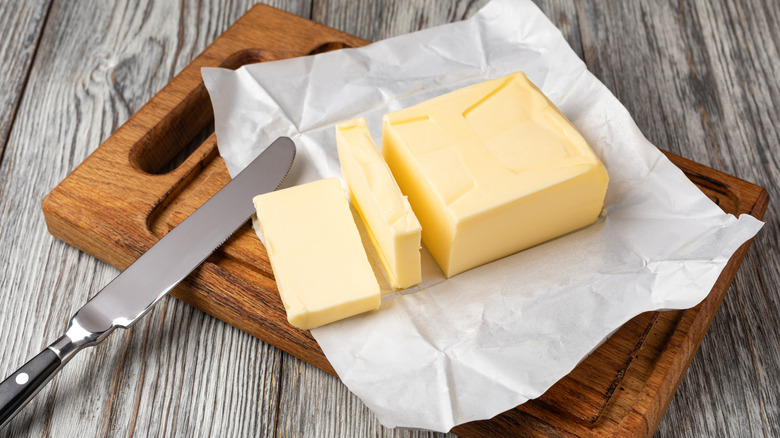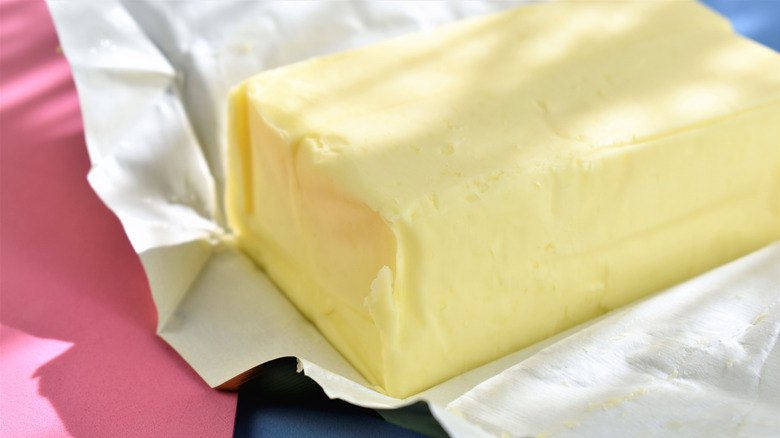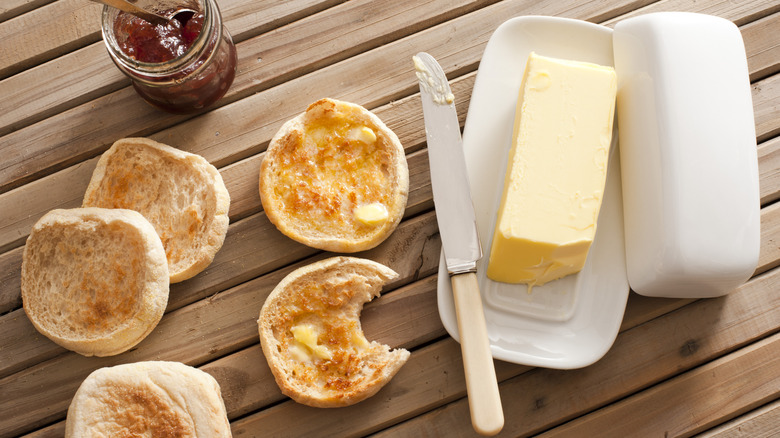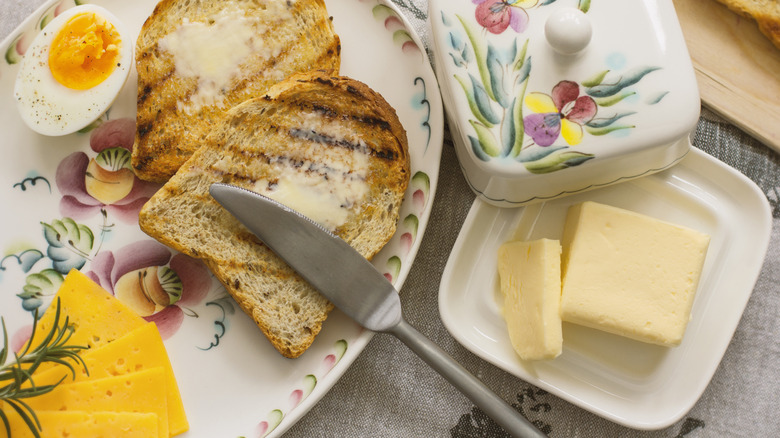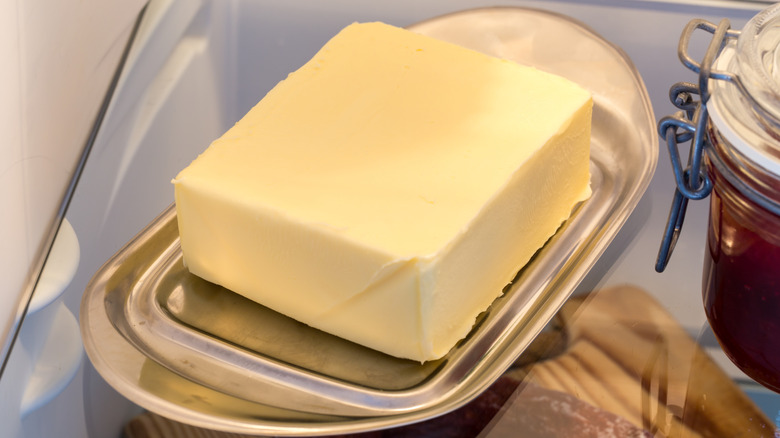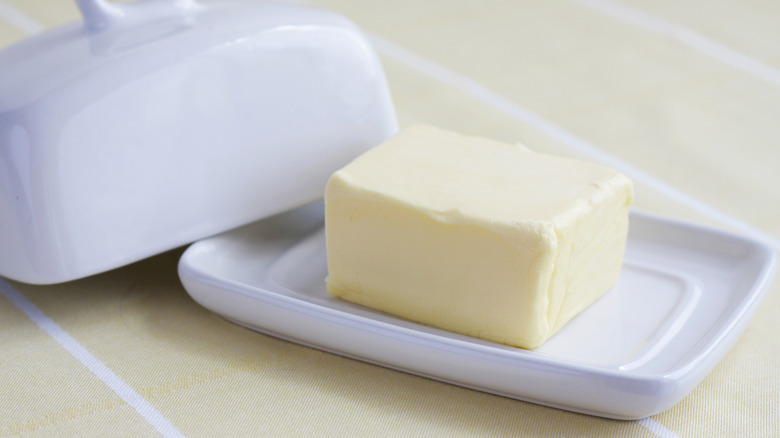The Easiest Ways To Store A Stick Of Butter And The Best Containers To Use, According To Celebrity Chefs
It can be shocking for some to see a stick of butter displayed so casually on a countertop, especially if you grew up with a chilly butter supply that rested inside a refrigerator, with the mindset that the cold temperatures preserve its freshness. While most people agree that butter is a universally delicious fat, there seems to be widespread disagreement about storing it. To get an expert's opinion on the matter, Food Republic spoke to chefs at the Nassau Paradise Island Wine & Food Fest about the best ways to store butter — including what container to use and where it should be placed.
Interestingly, we received a wide variety of answers from the professional chefs regarding butter storage techniques. Whether you host your butter in its original packaging in the fridge or keep a butter dish at room temperature, it seems that there are many discrepancies in what the correct storage vessel is. The great butter storage debate is further exacerbated by the fact that certain recipes call for different butter temperatures. For example, you should use softened butter to make the perfect cinnamon rolls, whereas cold butter is a must for pastries like biscuits, croissants, and pies.
Glenn Rolink opts for refrigerated storage
Glenn Rolink of Carmine's Italian Restaurant typically avoids the pitfalls of storing butter on the counter by keeping the ingredient in the fridge until it is needed. The chef told Food Republic that when he's cooking at home, he refrigerates his butter until an hour before he's ready to use it, which is when he'll take it out of the cold temperature. "I like it slightly soft. I don't like it to break. I like it to be able to be flexible when I cut it and cook with it," he shared.
Instead of using a container or a butter dish, Rolink said he prefers to store his butter in stick form, with the wrapper on, as it arrives from the store. If you follow this method, be sure to carefully unwrap your butter upon initial use — you don't want to reseal your butter in packaging that has been torn and tattered, as this could lead to your butter developing dry spots.
Michael Symon doesn't need water to keep his butter soft
Chef and cookbook author Michael Symon prefers to store his butter at room temperature, "on the counter, next to the toaster." When asked whether he uses a specific type of container, Symon shared that he is partial to a round butter caddy with a lid. An enclosed container such as this ensures that nothing gets into the butter while keeping it at room temperature.
While some chefs are fans of French butter dishes or butter bells — two-piece ceramic containers with a water seal that prevents air from getting in while keeping the butter fresh and at a perfectly spreadable temperature — Symon prefers to keep it simple. "No water," he clarified. Just a straightforward butter container with a decent lid.
Alon Shaya uses multiple storage techniques
Chef Alon Shaya is also on team room-temperature, as he often leaves his butter out when cooking at home. "We always have a little butter dish on the counter because we like it to be soft, " he said. Softened butter is not only easier to spread, but many baking instructions specifically call for room-temperature butter — it's the key to better cookies, for example. The expert added, "I like it when [the butter] gets a little funky."
However, Shaya also sometimes refrigerates his butter. You can technically return soften butter to the fridge, but it is a risky game if you don't have the proper container. When asked what kind of vessel he prefers for storing it, the chef shared that he is partial to his antique ceramic butter dish.
Kardea Brown isn't afraid to store butter in its own wrapper
Food Network Star and bestselling author Kardea Brown shared that she prefers to store her butter in the fridge, unless she's getting ready to bake. Many food safety experts agree with this method of storage — while you can safely leave your chilled butter out on the countertop for one to two days without risk of spoilage, refrigerating it will help keep the dairy product fresh for much longer.
When asked whether she prefers using a container or simply storing her butter in its wrapper, Brown admitted that she uses both methods, confirming that butter wrappers can be a versatile storage hack themselves. "Sometimes, when I'm in a rush, I'll just throw it in the fridge in the wrapper, but then I also have the butter container," the expert stated.
José Andrés enjoys salted butter at room temperature
In a discussion with Food Republic, chef José Andrés shared that he likes to store his butter in an ultra-convenient location: on the kitchen table. In terms of container choice, Andrés divulged that his butter resides in a little ceramic container alongside "a beautiful wooden knife," which is always kept inside.
Many of the chefs we spoke to said they often keep unsalted butter on hand because it allows you to better control the salt levels, but Andrés disagrees. The expert shared that he prefers to use salted butter if it is being stored outside of the refrigerator. "I buy both, but the salted butter doesn't oxidize the same way as the unsalted butter. Therefore I use salted," he said.

